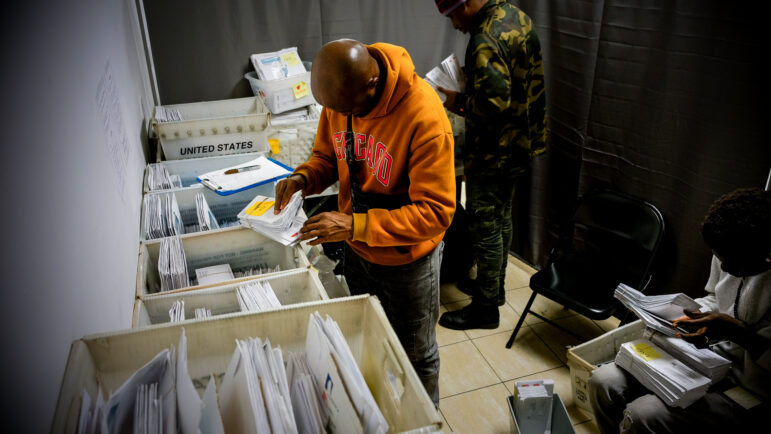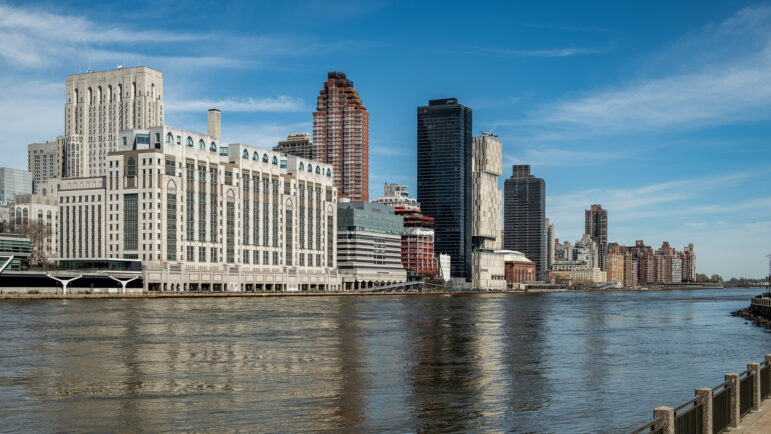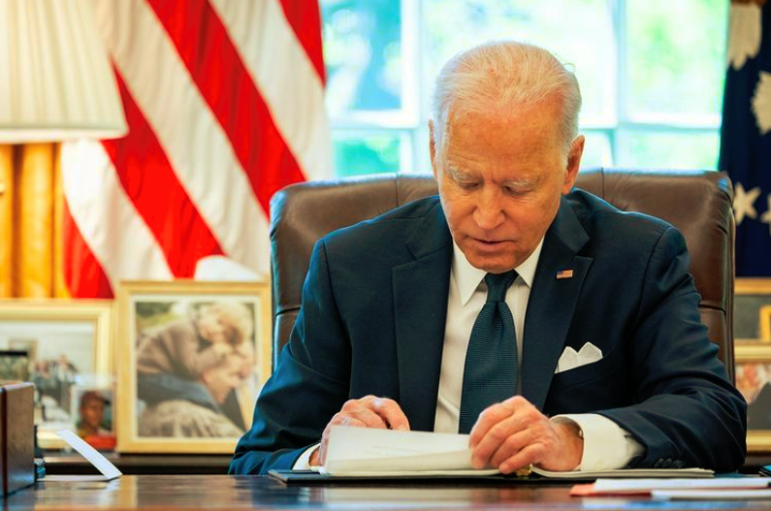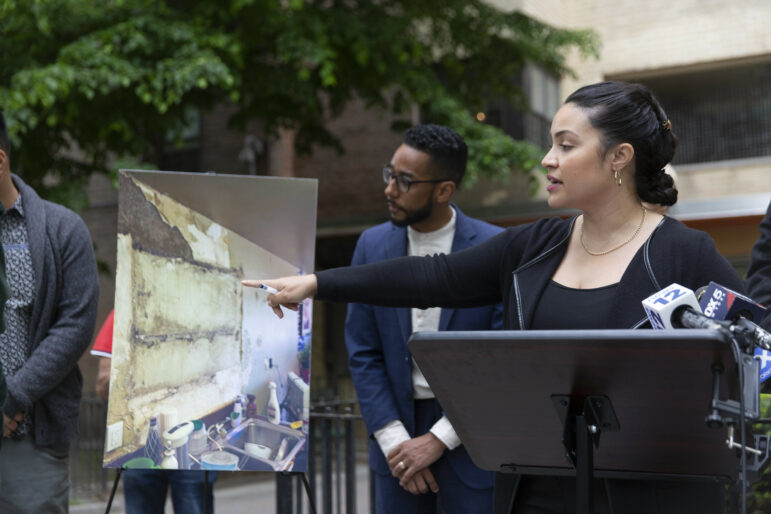
Adi Talwar
Members of the community board land use committee discuss the Chinatown rezoning.
After a prolonged battle between community groups and the De Blasio administration over whether to adopt a grassroots rezoning plan for all of Chinatown and the Lower East Side, Manhattan Community Board 3 is now trying to decide whether to give their blessings to the administration’s offer to conduct a rezoning study limited to just Chinatown.
On Wednesday night, members of the Community Board 3 Land Use Committee crafted a letter to the Department of City Planning (DCP) indicating that it will welcome the opportunity to engage in a process for a plan on the Chinatown area, while also emphasizing the board’s interest in meeting long-held goals for the adjacent neighborhoods, and leaving the door open for future discussion about how the city defines the borders of Chinatown.
The statement, the exact wording of which will not be public until it is voted on by the full board next week, received the approval of 12 out of the 13 present committee members after a long and heated committee meeting. Tunisia Riley, the one board member who did not vote in favor of the statement, expressed concerns that it risked allowing the administration to continue a process focused only on a narrow definition of Chinatown and not on the surrounding Lower East Side.
The neighborhood’s rezoning discussion is now eight years in the making. In 2008, after the board voted to approve a contextual rezoning for the East Village that critics said would push development pressures south, over 50 community groups joined the board in forming the Chinatown Working Group to design a rezoning plan geared at limiting out-of- context development and protecting working-class immigrants from displacement in Chinatown and the Lower East Side.
DCP has repeatedly rejected the final plan, issued in December 2013, as too expansive. When the community board suggested an alternative approach that would prioritize three subsections of the plan—the Chinatown core, NYCHA, and the waterfront—the city rejected that as well.
In the summer, however, DCP officials said they would be willing to consider rezoning the “Chinatown area,” though they left Chinatown’s borders up for redefinition. The proposal for a Chinatown-only study elicited protests from community residents and some board members at a September board meeting.
On Wednesday night, land-use committee chairperson MyPhuong Chung said DCP now wants to know whether the agency has the board’s support in moving forward with a Chinatown-only rezoning, and she conveyed her impressions that DCP has indicated they might be willing to discuss issues involving other parts of the area. That news provoked a variety of questions from board members on Wednesday night, including how DCP would define Chinatown’s borders and in what sense DCP would be willing to discuss the rest of the area.
Many members expressed fear that, if the board refused the opportunity to work with DCP, it will forfeit its last chance to protect any part of the neighborhood from high-rise luxury development.
“From the bottom of my heart I can say that Chinatown is at a crucial tipping point,” wrote board member Gigi Li, who was not present, in an e-mail that Chung read aloud at the start of the discussion, in which she emphasized her family’s long roots in Chinatown. “We cannot afford to do nothing. Nothing is what happened for this last quarter-century.” Addressing the two sub-areas the board had proposed rezoning in addition to Chinatown, Li said she recognized rezoning NYCHA would present many complicated issues, and noted that the waterfront has begun receiving the city’s attention in a separate process.
Nancy Ortiz, stressing her family’s deep roots in the Lower East Side, also expressed support for engaging with DCP.
“I just feel this is an opportunity to have dialogue and have discussion, versus just shutting the door,” she said.
In his support for moving forward to protect Chinatown, board member Tim Laughlin, who is president of a Lower East Side business improvement organization, criticized community activists who have demanded an all-or-nothing approach to a potential rezoning, saying the discussion with these activists had become “pretty much disgusting in my view.”
Others, however, argued that DCP’s definition of Chinatown would likely exclude the waterfront, which means the city would be ignoring an area that may be most at-risk for overdevelopment. Over four towers, all at least 60 stories, are expected to rise simultaneously within a two- block radius on the north side of the Manhattan Bridge and adjacent to the partially-completed, 80-story Extell tower, where one-bedroom condos were recently listed at a price of $1.179 million. These developments have elicited a variety of concern from residents, including the impacts of construction on surrounding buildings, burdens on infrastructure, and rising rents in the surrounding neighborhoods.
Those projects are allowed as-of-right within the current zoning, but if the grassroots zoning plan had been put in place earlier, development in that area would have been curbed to 350 feet or roughly 35 stories. In addition, the grassroots plan would have required each building to set aside 30 percent of units as below-market housing or as much as 50 percent if developers took advantage of the 421a tax credit—as opposed to the 25 percent currently offered on a voluntary basis by the four tower developers, and 20 percent by Extell.
After turning down a request from Council member Margaret Chin and other elected officials to institute a public review process for the four towers, the city has launched an environmental review process to investigate the cumulative effects of the developments. The city will host four public meetings [the first of which is Thursday evening at 6:30 p.m. at Gouverneur Health, 227 Madison Street] and ultimately produce an Environmental Impact Statement on the projects. The review process will also be guided by a community task force consisting of local elected officials, community board members, tenants, and business owners. Ultimately, the city will have the option to require the developer to implement mitigation strategies to combat harmful impacts.
Board member and executive director of Good Old Lower East Side (GOOLES) Damaris Reyes called on the committee to not dismiss the waterfront as a lost cause, as there are still parcels that could be redeveloped in the area, and noted that it was still unclear to her whether the city’s environmental review process will have any teeth. She added that she didn’t believe the city would return to the area to rezone other parts of the neighborhood in the near future, as the city has suggested might be an option.
“They’re not going to do concurrently, four of five [Environmental Impact Statements] over the years to accommodate looking at all these different parts of the plan … It’s going to be years, years before they consider another part of the neighborhood,” Reyes said, in a call to hold out for more than Chinatown.
Meanwhile, board member Cathy Dang, who is executive director of CAAAV, a Chinatown tenants rights organizations, said that Chinatown residents understand that “if there’s development pressures on the waterfront, it comes into Chinatown core anyway,” while Riley gave an impassioned appeal to the board to think about the unfairness of neglecting the “outside”—meaning the neighborhoods surrounding Chinatown.
“As far as I’m concerned, the LES, the East Village, and Chinatown, we work together as one, and if you only protect one and destroy the others, you will destroy them all regardless,” she said.
Most members of the board finally agreed to welcome a dialogue with DCP in the hopes that they can continue to push for a more inclusive definition of Chinatown and express their concerns about the rest of the neighborhood.









One thought on “Board Moves Toward a Yes—With Misgivings—to de Blasio Administration on Chinatown Rezoning”
The study needs to include LES! By just undertaking a rezoning of Chinatown implies narrow thinking. Look what is happening in the East Village (Loisaida Area), the community is now so over crowded that the former character of the neighborhood is being lost. And this is what attracted the people to the area in the first place. An amended zoning plan limiting the density is the only strategy that will sustain what remains of “Our Good Old Lower East Side”. I am disturbed by the LES leadership on CB#3, to surrender to DCP by only approving the rezoning study for Chinatown. What happen to phasing a plan? The areas infrastructure is presently challenged and will only become worse in the future if the rezoning does not include a comprehensive rezoning of the LES area. Until then the community should not chose just one niegborhood over another. Do Not Surrender Protecting The LES. DCP’s recommendation of only undertaking a rezoning of Chinatown is a “divide and ignore strategy/tactic”…The areas leadership should pool its resources and continue to advocate for the comprehensive rezoning.